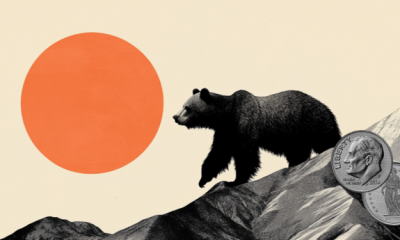

others
Canadian Dollar slips after markets go USD-bullish on US PMI data beat – Crypto News
- Canadian Dollar falls back as investors pile into USD once more.
- Crude Oil extends Monday’s losses, evaporating CAD support with it.
- The Bank of Canada is due for its latest rate statement on Wednesday.
The Canadian Dollar (CAD) has slipped back into its lowest bids in almost three weeks against the US Dollar (USD) as broad-market flows reverse direction and pile back into the Greenback following a bumper reading for the US Purchasing Managers’ Index (PMI) that soundly thumped market expectations.
The Bank of Canada (BoC) is set to announce its latest rate call on Wednesday, and Loonie traders will be looking for the Canadian central bank to hold their reference rate at 5% while leaving the way open for more potential hikes to come later on. Market participants expect little change in the BoC’s forward guidance as Canadian policymakers grapple with a domestic economy that is seeing flagging growth indicators but still high inflation on the back of soaring energy prices.
Crude Oil prices are seeing a downside snap on Tuesday, with West Texas Intermediate (WTI) adding to Monday’s decline. The oil-backed Loonie is seeing its supportive base go up in smoke as crude barrels backslide, pushing the CAD into its lowest prices against the USD since October 5.
Daily Digest Market Movers: Canadian Dollar slips as broader market picks up the Greenback
- CAD fumbles to an almost three-week low as investors bid the USD.
- US October PMIs beat the Street, climbing over Wall Street’s forecasts to chalk in gains for the productivity indicator.
- The US Manufacturing PMI printed at a flat 50 versus the expected 49.5 decline from the previous 49.8 reading.
- The US Services PMI gave an impressive reading, coming in at 50.9 and handily vaulting over the forecasted 49.9 against September’s 50.1.
- The dual PMI beats sent the Composite PMI back to 51, its highest reading since July.
- Crude Oil continues to slide, dragging down CAD support with it.
- WTI barrels are down over 7.5% from Friday’s peak.
- BoC Preview: keeping rates on hold and the prospect of further hikes alive
Technical Analysis: Canadian Dollar gives up more ground as investors favor the US Dollar, USD/CAD taps 1.3755
The Canadian Dollar (CAD) is down almost 0.7% against the US Dollar (USD) in Tuesday’s trading session as markets go broadly USD bullish, taking the USD/CAD pair to its highest bids in almost three weeks.
The USD/CAD pinged 1.3755 on Tuesday after reversing direction from an intraday low of 1.3661. The next immediate barrier for USD/CAD bulls will be October’s early high of 1.3785, while the floor for sellers currently sits at the last swing low near 1.3569.
The US Dollar has gained nearly 5% against the Canadian Loonie since July’s low point near 1.3090, and the USD/CAD continues to find technical support from the 50-day Simple Moving Average (SMA) currently lifting into 1.3600.
An extended rally will see the USD/CAD set for a challenge of 2023’s highs at 1.3862, while a full bearish reversal will find the floorboards near the 200-day SMA currently parked just south of 1.3500.
USD/CAD Daily Chart
US Dollar price today
The table below shows the percentage change of US Dollar (USD) against listed major currencies today. US Dollar was the strongest against the .
| USD | EUR | GBP | CAD | AUD | JPY | NZD | CHF | |
| USD | 0.76% | 0.72% | 0.34% | -0.29% | 0.07% | 0.17% | 0.32% | |
| EUR | -0.77% | -0.04% | -0.44% | -1.07% | -0.70% | -0.60% | -0.46% | |
| GBP | -0.73% | 0.03% | -0.39% | -1.03% | -0.67% | -0.57% | -0.42% | |
| CAD | -0.34% | 0.43% | 0.39% | -0.63% | -0.27% | -0.17% | -0.03% | |
| AUD | 0.30% | 1.06% | 1.01% | 0.63% | 0.36% | 0.47% | 0.60% | |
| JPY | -0.07% | 0.69% | 0.64% | 0.27% | -0.39% | 0.10% | 0.23% | |
| NZD | -0.17% | 0.61% | 0.56% | 0.17% | -0.47% | -0.10% | 0.14% | |
| CHF | -0.32% | 0.45% | 0.41% | 0.03% | -0.61% | -0.24% | -0.15% |
The heat map shows percentage changes of major currencies against each other. The base currency is picked from the left column, while the quote currency is picked from the top row. For example, if you pick the Euro from the left column and move along the horizontal line to the Japanese Yen, the percentage change displayed in the box will represent EUR (base)/JPY (quote).
Risk sentiment FAQs
In the world of financial jargon the two widely used terms “risk-on” and “risk off” refer to the level of risk that investors are willing to stomach during the period referenced. In a “risk-on” market, investors are optimistic about the future and more willing to buy risky assets. In a “risk-off” market investors start to ‘play it safe’ because they are worried about the future, and therefore buy less risky assets that are more certain of bringing a return, even if it is relatively modest.
Typically, during periods of “risk-on”, stock markets will rise, most commodities – except Gold – will also gain in value, since they benefit from a positive growth outlook. The currencies of nations that are heavy commodity exporters strengthen because of increased demand, and Cryptocurrencies rise. In a “risk-off” market, Bonds go up – especially major government Bonds – Gold shines, and safe-haven currencies such as the Japanese Yen, Swiss Franc and US Dollar all benefit.
The Australian Dollar (AUD), the Canadian Dollar (CAD), the New Zealand Dollar (NZD) and minor FX like the Ruble (RUB) and the South African Rand (ZAR), all tend to rise in markets that are “risk-on”. This is because the economies of these currencies are heavily reliant on commodity exports for growth, and commodities tend to rise in price during risk-on periods. This is because investors foresee greater demand for raw materials in the future due to heightened economic activity.
The major currencies that tend to rise during periods of “risk-off” are the US Dollar (USD), the Japanese Yen (JPY) and the Swiss Franc (CHF). The US Dollar, because it is the world’s reserve currency, and because in times of crisis investors buy US government debt, which is seen as safe because the largest economy in the world is unlikely to default. The Yen, from increased demand for Japanese government bonds, because a high proportion are held by domestic investors who are unlikely to dump them – even in a crisis. The Swiss Franc, because strict Swiss banking laws offer investors enhanced capital protection.
-

 Blockchain1 week ago
Blockchain1 week agoThe CFO and Treasurer’s Guide to Digital Assets – Crypto News
-

 Cryptocurrency1 week ago
Cryptocurrency1 week agoSolana Price Upside Prevails After Securing Key Support, $127 In Focus – Crypto News
-
Cryptocurrency5 days ago
Pi Community Highlights Pi Coin’s Slow Growth As ‘Strategic’ – Crypto News
-

 Technology1 week ago
Technology1 week agoMicrosoft’s Greatest Hits and Epic Fails: A 50-Year Wild Ride – Crypto News
-

 others1 week ago
others1 week agoThere is more work to do on inflation – Crypto News
-

 Cryptocurrency6 days ago
Cryptocurrency6 days agoWhite House Mulls Bitcoin Reserve Backed by Gold and Tariffs – Crypto News
-
Business4 days ago
Cardano (ADA) and Dogecoin (DOGE) Eye For Bullish Recovery – Crypto News
-

 Business4 days ago
Business4 days agoWorldpay and FIS Deals Echo 2019’s Payments Megamergers – Crypto News
-

 Blockchain1 week ago
Blockchain1 week agoBreakout To $1,800 With These Two Supply Zones – Crypto News
-

 Metaverse1 week ago
Metaverse1 week agoAmul girl to Nirma: Viral AI video brings classic Indian mascots to life, users stir debate over ethics – Crypto News
-
others1 week ago
Russia Consumer Price Index (MoM) down to 0.65% in March from previous 0.8% – Crypto News
-

 Cryptocurrency1 week ago
Cryptocurrency1 week agoDOGE Price Moves as Dogecoin Whales Go on Buying Spree – Crypto News
-

 Blockchain1 week ago
Blockchain1 week agoHow to mine Bitcoin at home in 2025: A realistic guide – Crypto News
-

 Cryptocurrency1 week ago
Cryptocurrency1 week agoProfessor Coin: What’s Driving Cryptocurrency Adoption Around the World – Crypto News
-

 Blockchain1 week ago
Blockchain1 week agoCZ claps back against ‘baseless’ US plea deal allegations – Crypto News
-

 Technology1 week ago
Technology1 week agoApple ramps up India production amid China uncertainty, assembles $22 billion worth iPhones in a year – Crypto News
-

 others1 week ago
others1 week agoGold consolidates near all-time peak as bulls pause for breather – Crypto News
-

 Cryptocurrency4 days ago
Cryptocurrency4 days agoOKX Returns to US Market Following $505M DOJ Deal – Crypto News
-
Technology3 days ago
Expert Predicts Pi Network Price Volatility After Shady Activity On Banxa – Crypto News
-

 others1 week ago
others1 week agoBinance Issues Important Update On 10 Crypto, Here’s All – Crypto News
-

 others1 week ago
others1 week agoRipple Community Remains Disappointed With Hinman Report, What’s Next? – Crypto News
-

 others1 week ago
others1 week agoOn-Chain Indicator Suggests Ethereum (ETH) Could Be Undervalued, According to Crypto Analyst – Crypto News
-

 others1 week ago
others1 week agoMexican Peso ends week strong as USD plunges on China tariff retaliation – Crypto News
-
![Shiba Inu [SHIB] price prediction - A 70% rally next after 900%+ burn rate hike?](https://dripp.zone/news/wp-content/uploads/2025/04/Shiba-Inu-SHIB-price-prediction-A-70-rally-next-400x240.png)
![Shiba Inu [SHIB] price prediction - A 70% rally next after 900%+ burn rate hike?](https://dripp.zone/news/wp-content/uploads/2025/04/Shiba-Inu-SHIB-price-prediction-A-70-rally-next-80x80.png) Cryptocurrency1 week ago
Cryptocurrency1 week agoShiba Inu [SHIB] price prediction – A 70% rally next after 900%+ burn rate hike? – Crypto News
-

 Metaverse1 week ago
Metaverse1 week agoForget DeepSeek. Large language models are getting cheaper still – Crypto News
-

 others1 week ago
others1 week agoCrypto Strategist Sees Solana-Based Memecoin Surging Higher, Says One AI Altcoin Flashing Strong Chart – Crypto News
-

 Cryptocurrency1 week ago
Cryptocurrency1 week agoPepe is on the verge breakout to $0.0000078 as gold cross nears. – Crypto News
-

 Blockchain6 days ago
Blockchain6 days agoOn-Chain Clues Suggest Bitcoin Bounce Might Be a False Signal—Here’s What to Know – Crypto News
-

 Blockchain4 days ago
Blockchain4 days agoBitcoin online chatter flips bullish as price chops at $85K: Santiment – Crypto News
-

 Cryptocurrency4 days ago
Cryptocurrency4 days agoJudge Pauses 18-State Lawsuit Against SEC, Saying It Could ‘Potentially Be Resolved’ – Crypto News
-
Business4 days ago
Coinbase Reveals Efforts To Make Its Solana Infrastructure Faster, Here’s All – Crypto News
-
Technology4 days ago
Coinbase Reveals Efforts To Make Its Solana Infrastructure Faster, Here’s All – Crypto News
-

 others1 week ago
others1 week agoGBP advance lags core peers – Scotiabank – Crypto News
-

 Blockchain1 week ago
Blockchain1 week agoBTC, ETH, XRP, BNB, SOL, DOGE, ADA, LEO, LINK, AVAX – Crypto News
-

 Blockchain1 week ago
Blockchain1 week agoBitcoin Poised For W-Bottom Reversal, Says John Bollinger – Crypto News
-

 Technology1 week ago
Technology1 week agoDogecoin Price Gearing for A 3X Rally Amid DOGE Whale Accumulation – Crypto News
-

 Technology1 week ago
Technology1 week agoHow to transcribe and translate YouTube videos for free using Gemini 2.5 Pro? Check our step-by-step guide – Crypto News
-

 Cryptocurrency1 week ago
Cryptocurrency1 week agoFusaka fork takes shape as Pectra enters final stretch – Crypto News
-

 Blockchain1 week ago
Blockchain1 week agoXRP Price To Hit $45? Here’s What Happens If It Mimics 2017 And 2021 Rallies – Crypto News
-

 Cryptocurrency1 week ago
Cryptocurrency1 week agoBitcoin – Here’s what’s next after sellers near exhaustion levels – Crypto News
-
![Bearish sequence in Nifty favors downside [Video]](https://dripp.zone/news/wp-content/uploads/2025/02/Bearish-sequence-in-Nifty-favors-downside-Video-Crypto-News-400x240.png)
![Bearish sequence in Nifty favors downside [Video]](https://dripp.zone/news/wp-content/uploads/2025/02/Bearish-sequence-in-Nifty-favors-downside-Video-Crypto-News-80x80.png) others1 week ago
others1 week agoDow Jones recovers ground to post one of its best weeks in years – Crypto News
-

 Blockchain1 week ago
Blockchain1 week ago‘Bitcoin Standard’ author to develop Austrian economics curriculum for UK school – Crypto News
-

 Business1 week ago
Business1 week agoMichael Saylor Hints At Another MicroStrategy Bitcoin Purchase, BTC Price To Rally? – Crypto News
-

 others6 days ago
others6 days agoChina’s Copper imports drop – ING – Crypto News
-

 Cryptocurrency5 days ago
Cryptocurrency5 days agoA decade in, Liberland needs the Bitcoin standard more than ever – Crypto News
-

 Blockchain4 days ago
Blockchain4 days agoStablecoins’ dominance due to limitations of US banking — Jerald David – Crypto News
-

 Technology4 days ago
Technology4 days agoIndia, Australia explore bilateral data-sharing treaty to tackle cybercrime – Crypto News
-
Business4 days ago
Crypto Whales Bag $20M In AAVE & UNI, Are DeFi Tokens Eyeing Price Rally? – Crypto News
-

 Blockchain4 days ago
Blockchain4 days agoJio partnership to drive real-world Web3 adoption for 450M users – Crypto News
-

 Metaverse4 days ago
Metaverse4 days agoLe Chat, the cat-bot France has pinned its AI hopes on – Crypto News












